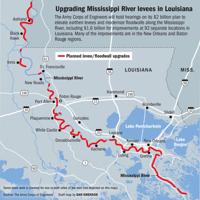
Posted on September 2, 2020
The Army Corps of Engineers is proposing $2 billion in upgrades to the levee system along the Mississippi River from Missouri to the Gulf of Mexico, with the majority of the projects aimed at shoring up protections for areas in Louisiana around New Orleans and Baton Rouge.
The work, which is still in the planning stages, would be divided into 143 individual projects in seven states, with the lion’s share – 92 projects totaling $1.6 billion – in Louisiana.


Map shows planned levee and floodwall upgrades along the Mississippi River, 2020.
The Louisiana parts of the upgrades, which are aimed at both sides of the river, would include more than 140 miles of levee lifts of as much as 3 feet, with most between 1 and 2 feet, and the replacement of nearly 8 miles of floodwalls with stronger and taller walls. The wall work is almost all in New Orleans, including floodwalls along the Port of New Orleans and in the French Quarter and possibly at Algiers Point.
The projects were identified during inspections after high-river events in recent years that have stressed or damaged portions of the levee system. Some projects grew out of required reviews of post-Katrina design standards used in building individual levee and floodwall segments.


The Corps also reviewed water levels during a record 2011 high-river period along the river, examined the effects of climate change on future rainfall, and concluded that a 1955 “hypo flood” – a hypothetical combination of worst-case storms that produced significant rainfall and runoff — remains the “project design flood” to be used in determining levee heights.
In Louisiana, the report found that a “high” climate change-caused sea level rise would add 0.1 foot of water to the river at Baton Rouge and 1.1 feet at Venice, and that information has been used in reviewing required water levels.
The Corps is separately developing plans to address the effects of surge levels in the river during hurricanes for the east bank and West Bank hurricane levee systems over the next 50 years, including portions of the river levees that serve double duty as portions of the hurricane levee system.


The Corps is currently soliciting public comments on an environmental report supporting the $2 billion plan. If the environmental report is adopted after public hearings in October, the individual projects would compete to be included in future Corps annual budgets for approval by Congress. Given all the variables, it remains unclear when construction might begin on any specific project.


The projects would address locations where levees and floodwalls no longer meet Corps standards regarding overtopping, or where seepage concerns require improvements, such as:
- Raising and enlarging earthen levees where they are too low, with work occurring on the land or river side of the existing levee, or straddling the existing levee section.
- Replacing I-shaped floodwalls that normally are built atop sheet piles with thicker, more stable upside-down T-shaped floodwalls, supported by much longer, H-shaped “batter piles” driven diagonally outward on both sides of the wall for more stability.
- Adding earthen berms on the land side of levees where seepage has occurred to reinforce the top layer of ground and to reduce upward pressure of water that might be seeping through.
- Adding relief wells to intercept water seeping beneath a levee, with the water directed to an existing or new drainage system. The wells reduce the chance that the seepage will wash away soil in the levee.
- Installing metal sheet piles in earthen levee sections that are long enough to cut off seepage through and beneath the levee.
The Corps announced in March 2018 that this report would have to be completed to support the new work for the levee system, and public comments were requested on what it should contain in September 2018.


The study considered a variety of alternatives for levee improvements, including taking no action, an alternative required by law to be considered, which was rejected as being too risky. “The probability of a failure in the system would likely be highest at the areas identified as deficient,” the report said. “It is not likely that all of the areas would fail during a flood, but a single failure at any point would result in catastrophic damages.”
The Mississippi River and Tributaries system, the official name of the levee system that begins in Minnesota, was approved by Congress long before more modern alternatives to the use of levees, such as elevating buildings above floodplains or considering nature-based alternatives, and the improvement project was not required to consider them, the report said.


Here are some examples of the individual projects:
In the Baton Rouge area, a 2 1/2-mile stretch of levee at Port Allen will be elevated by 2 feet, with part of the levee’s center line shifted towards the land side. About 9 acres of cropland is expected to be used for clay borrow for the levee lift.
Less than a tenth of a mile of levee will be elevated about a foot at Ben Hur Road on the east bank.
In St. James Parish, a 1.3-mile stretch of west bank levee will be raised about 3 feet, using material taken from a borrow area on the river side of the levee in a cropland area, the report said.
A 3.8-mile stretch of levee on the east bank from Paulina to Gramercy will be elevated by 2 1/2 feet, using material taken from another 10-acre spot of croplland on the land side of the levee.
A small segment of existing levee and floodwall near Waggaman and Bridge City will be replaced, with a pile-founded concrete T-wall.
In New Orleans, a 1.37-mile segment of I-wall floodwall will be replaced with a stronger, pile-founded T-wall. Similar stretches of I-wall will be replaced with T-walls at Louisiana Avenue Wharves C&D, between Louisiana Avenue and Poydras Street, at Spanish Plaza, and between Canal and Toulouse streets.
Floodwalls will also be replaced in the Holy Cross neighborhood, in Arabi, and along part of the Chalmette Battlefield.
Segments of levees also will be elevated on the east bank in St. Bernard Parish and along long stretches of the east and west bank in Plaquemines Parish.
The draft report and appendices explaining all of the projects are available online at the Corps’ Vicksburg District website at: http://www.mvk.usace.army.mil/MRLSEIS/
Public meetings to provide information and collect comments on the final supplemental environmental statement will be held online because of the coronavirus pandemic. Dates and times have not yet been set. Comments can also be sent by email to MRL-SEIS-2@usace.army.mil or by mail to District Engineer, U.S. Army Corps of Engineers, Vicksburg District, 4155 Clay St., Vicksburg, Mississippi 39138-3435
Source: nola





